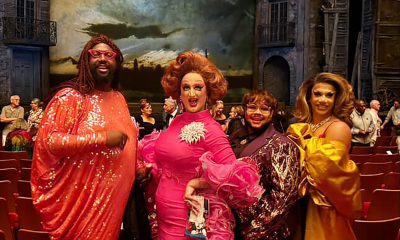Arts & Entertainment
‘Henry,’ ‘Hamlet’ and ‘Hair’
Full-scale productions, staged readings and big-name one nighters among season’s fare
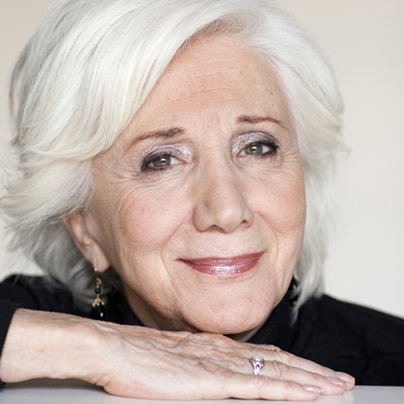
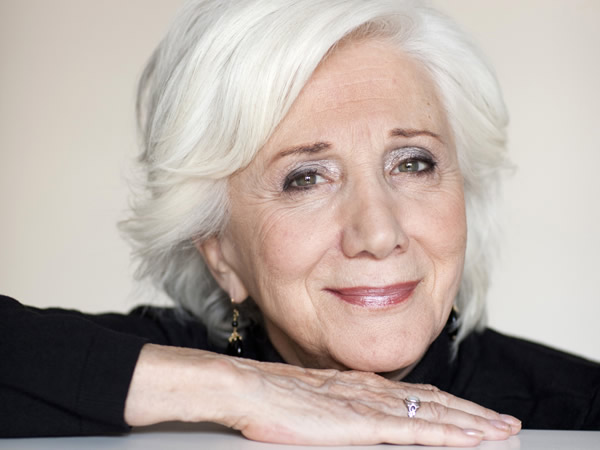
Actress Olympia Dukakis performs a reading of her one-woman show ‘Rose’ at the Strathmore March 13. (Photo courtesy Strathmore)
With so many new and familiar musicals, plays and performances busting out all over, spring is an especially busy time for D.C.-area theater. And many of the season’s hottest tickets are of special interest to LGBT audiences.
Signature Theatre is premiering a musical adaptation of “Beaches” (through March 30), based on the novel previously adapted for the big screen as the 1988 tearjerker starring Bette Miller and Barbara Hershey. Signature’s out artistic director Eric Schaeffer is staging the production. Broadway veterans Alysha Umphress and Mara Davi respectively play odd couple longtime friends Cee Cee and Bertie.
Also at Signature, out director Matthew Gardiner is staging a revival of the Berthold Brecht/Kurt Weill scathing musical critique of capitalism “Three Penny Opera” (April 22-June 1). The cast features Rick Hammerly (also gay) as scheming Lucy Brown, a part played memorably by Bea Arthur in the 1950s off-Broadway version.
WSC Avant Bard is currently presenting “Orlando” (thru March 23), playwright Sarah Ruhl’s adaptation of Virgnia Woolf’s 1928 novel about a man who becomes a woman. Talented local actor Sara Barker plays the title role. Amber Jackson directs.
The Gay Men’s Chorus of Washington presents “Von Trapped” (March 12-14). It’s a sure-to-be gay parody of “The sound of Music” featuring those familiar characters and beloved songs but with a twist. James Ellzy is the director/choreography.
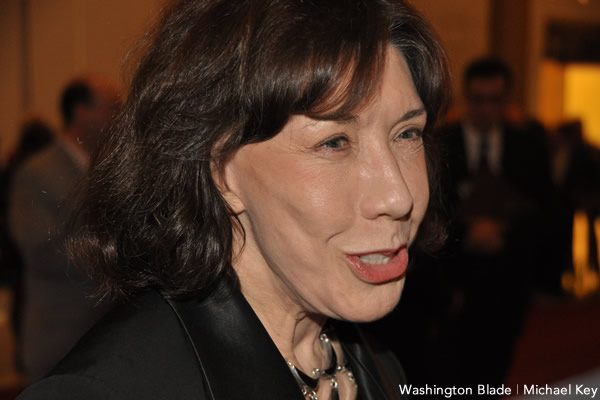
Lily Tomlin (Washington Blade file photo by Michael Key)
Comic icon Lily Tomlin comes to the Strathmore in Bethesda, Md., on March 28. In her live act, Tomlin, who recently married longtime partner Jane Wagner, uses her familiar roster of characters like Ernestine the telephone operator and precocious brat Edith Ann to hilariously comment on the human condition. Olympia Dukakis will perform a reading of her one-woman show “Rose,” which tells of a Jewish woman who has survived major events of the 20th century, at the Strathmore on March 13.
As part of its World Stages: International Theatre Festival, the Kennedy Center presents a staged reading of gay playwright Samuel D. Hunter’s “A Great Wilderness” on March 22, a story of an older man who has devoted his life to counseling teen boys not to be gay. About to retire, he takes one last client who forces him to confront his own demons.
The Keegan Theatre (located on Church Street, N.W., a half block walk from JR.’s Bar) presents “Hair” (March 15-April 12), the acclaimed ‘60s rock musical that celebrates youth, protest, free love, and, of course, hair. The show’s co-creators James Rado and Gerome Ragni shared an intimate relationship that inspired the show’s groundbreaking relaxed attitude toward sexuality.
The Shakespeare Theatre Company’s out artistic director Michael Kahn is staging both “Henry IV Part 1” (March 25-June 7) with Stacey Keach playing Falstaff, and the “Henry IV Part 2” (April 1-June 8) with local big talent Edward Gero in the title role.
Synetic Theatre is reviving its Helen Hayes Award-winning production of “Hamlet,” the first in its enormously successful Silent Shakespeare series, which relies on movement rather than words to tell the story. Out actor Alex Mills plays the gloomy Danish prince. It runs March 13-April 6.
Every April 12, parties are held throughout the world celebrating Russian Cosmonaut Yuri Gagarin’s historic 1961 first manned space flight. D.C.’s “Countdown to Yuri’s Night” (C2YN) offers an artistic spin on this high-science holiday by combining an art exhibition, a space-themed burlesque show, band performances and a dance party. Entertainers include New York-based burlesque star Mr. Gorgeous and out performer Patrick Doneghy. This year’s venue is the spanking new Anacostia Arts Center.
In May, gay director John Waters brings his one-man show “This Filthy World” (May 16) to the Birchmere in Alexandria. For just one performance, the Baltimore-based film legend will share insights on his journey from trash genre cult favorite to bankable Hollywood director.
Gay playwright Peter Sinn Nachtrieb’s “The Totalitarians” (June 2-29) makes its area premier in a production staged by out director Robert O’ Hara at Woolly Mammoth. Set against the backdrop of Nebraska-based political campaign, this high-energy farce pokes fun at the inanity of political language.
With “Jarman (all this maddening beauty),” force/collision pays tribute to Derek Jarman, the British avant-garde artist and filmmaker who died of an AIDS-related illness 20 years ago. A mash-up of video and live performance, “Jarman” is written by playwright Caridad Svich and will be directed and performed by the ensemble company’s out founding director John Moletress. First workshop performances are scheduled for April 17-27 at the Atlas Performing Arts Center.
Holly Twyford, celebrated local actor and now director who is gay, is staging Factory 449’s “The Amish Project” (April 17-May 11), playwright Jessica Dickey’s account of the tragic Amish one-room schoolhouse shootings that took place in Nickel Mines, Pa., in 2006, and its effects on the community. The production will be mounted at the Anacostia Arts Center.
On April 21, it’s the annual Helen Hayes Awards, honoring outstanding work in professional local theater from 2013. The event will be held for the first time at the National Building Museum.
Over the last weekend in May, the D.C. Queer Theatre Festival marks its third annual celebration the underrepresented voices and diversity of queer artists. The festival features new plays with themes relevant to the D.C. area and local artists with roots in the community. It also aims to meld quality theater with activism and charity.
This spring, the Rainbow Theatre Project, D.C.’s new company committed to presenting LGBT-themed plays and musicals, continues its inaugural season with one night staged readings of gay playwright Noel Coward’s “Long Island Sound (March 17), a comedy of bad manners featuring out actor Rick Hammerly; and “Yank!”(May 5), a musical about a gay romance during World War II to be staged by Hammerly, who must be among the hardest working local theater folks this spring.

The fifth annual Fredericksburg Pride march and festival was held on Saturday, June 28. A march through the streets of downtown Fredericksburg, Va. was followed by a festival at Riverfront Park.
(Washington Blade photos by Michael Key)
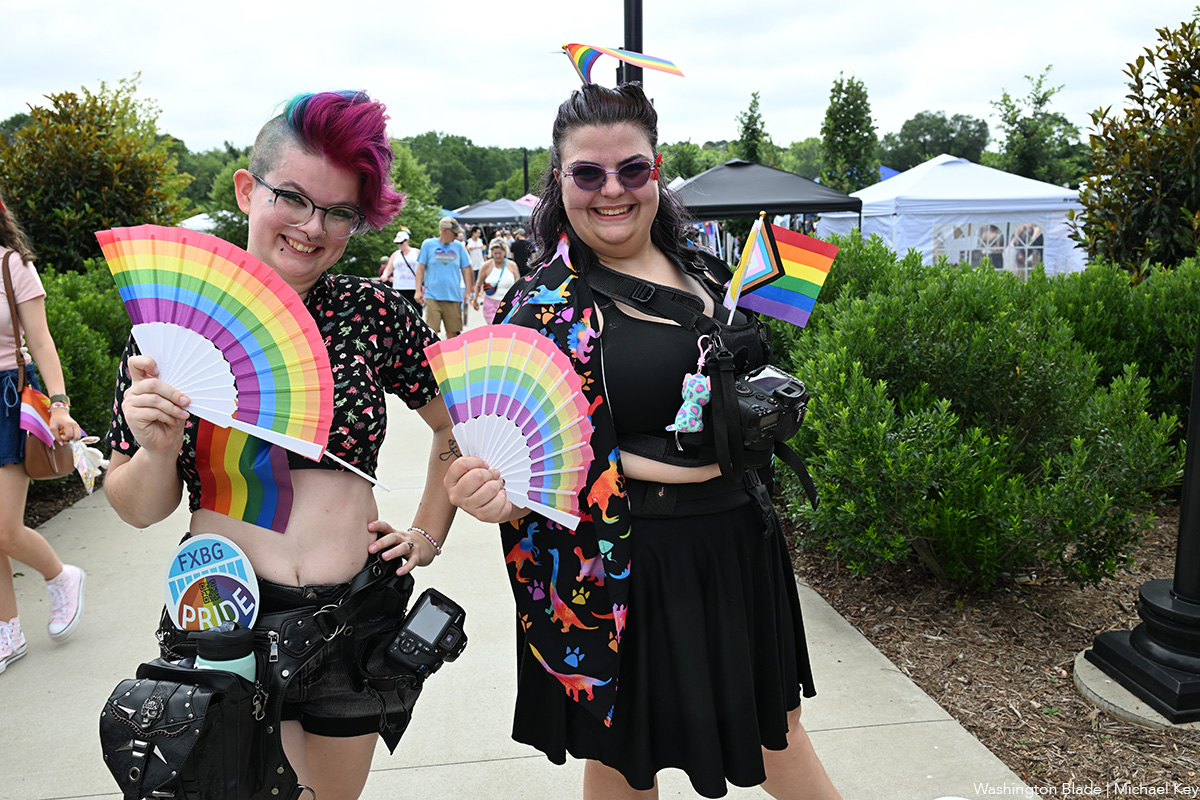
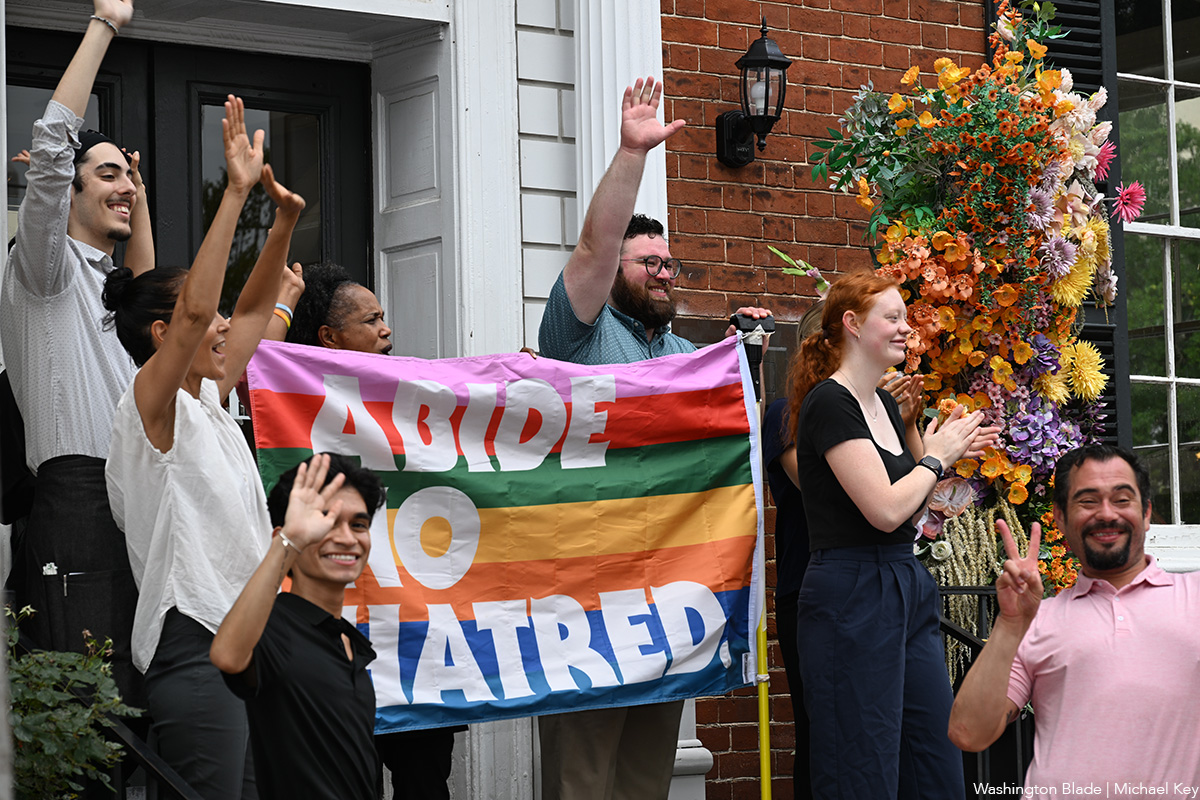
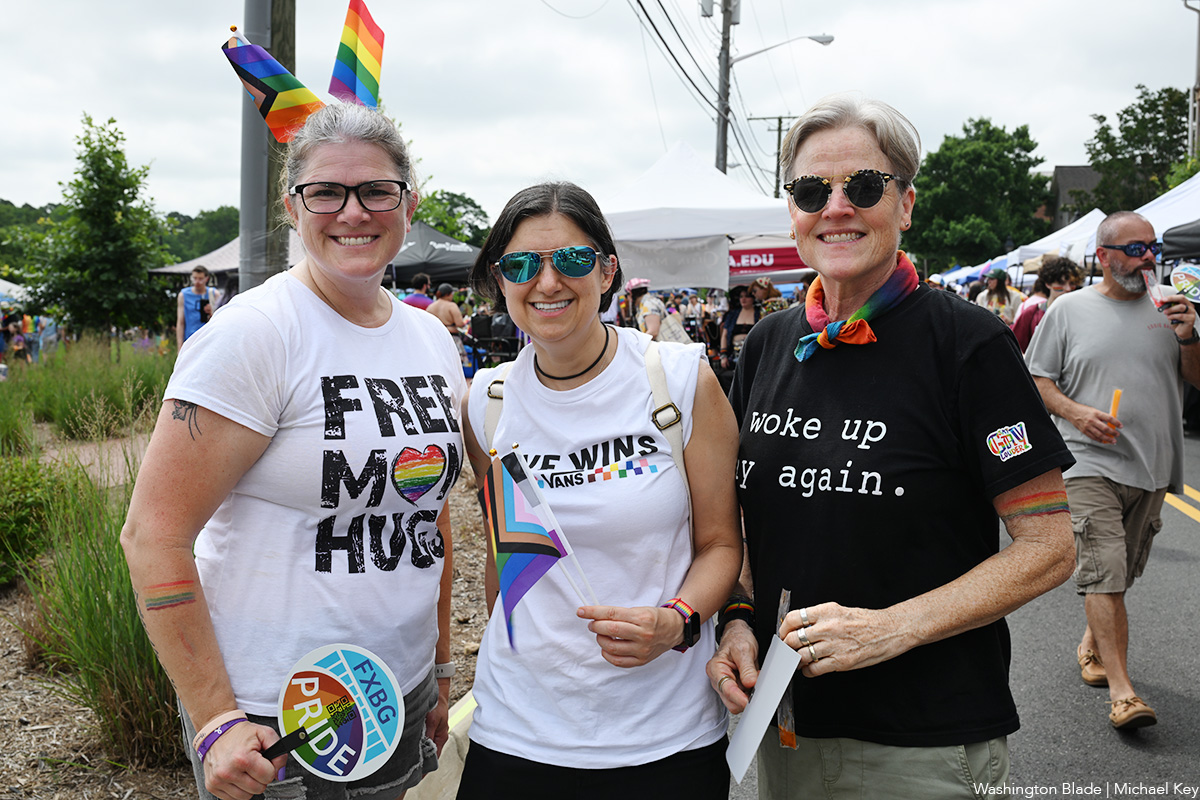

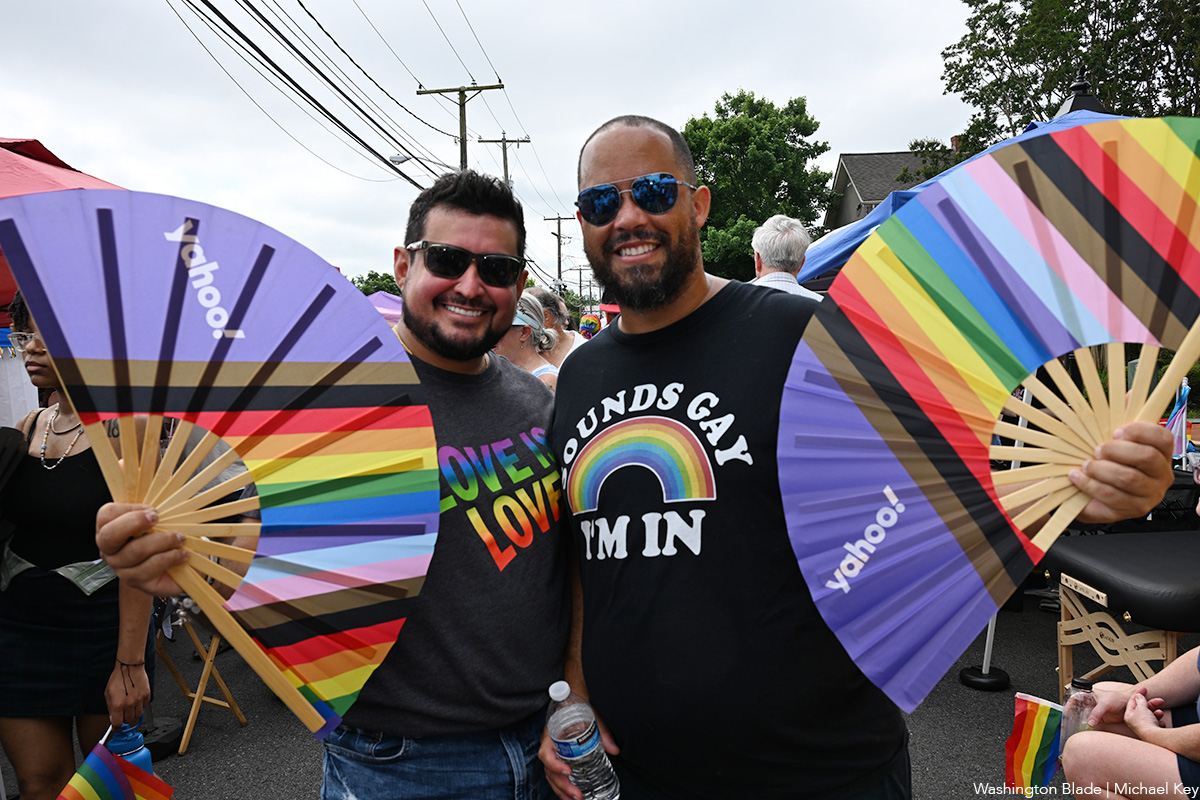










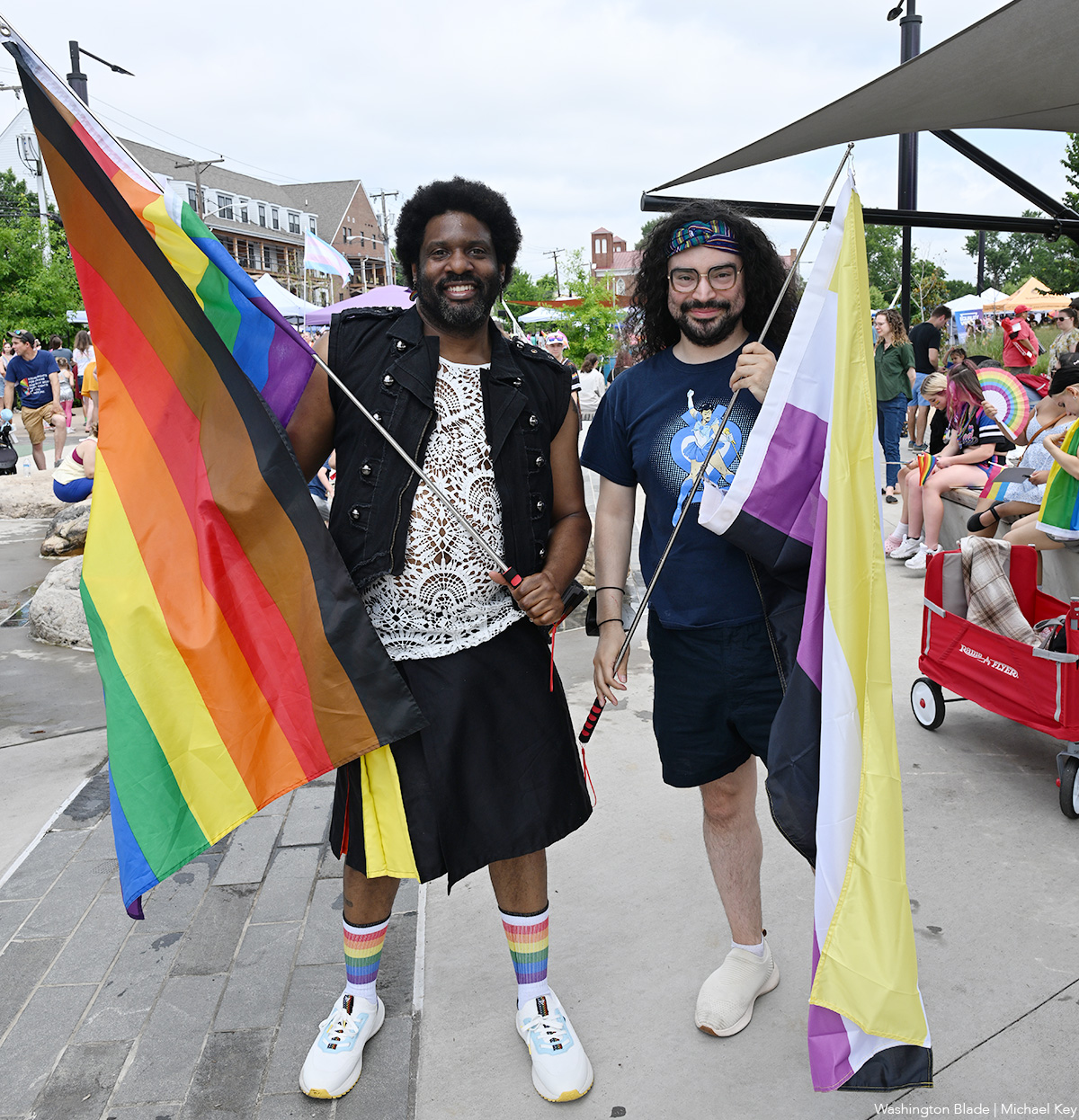



India
Anaya Bangar challenges ban on trans women in female cricket teams
Former Indian cricketer Sanjay Bangar’s daughter has received support
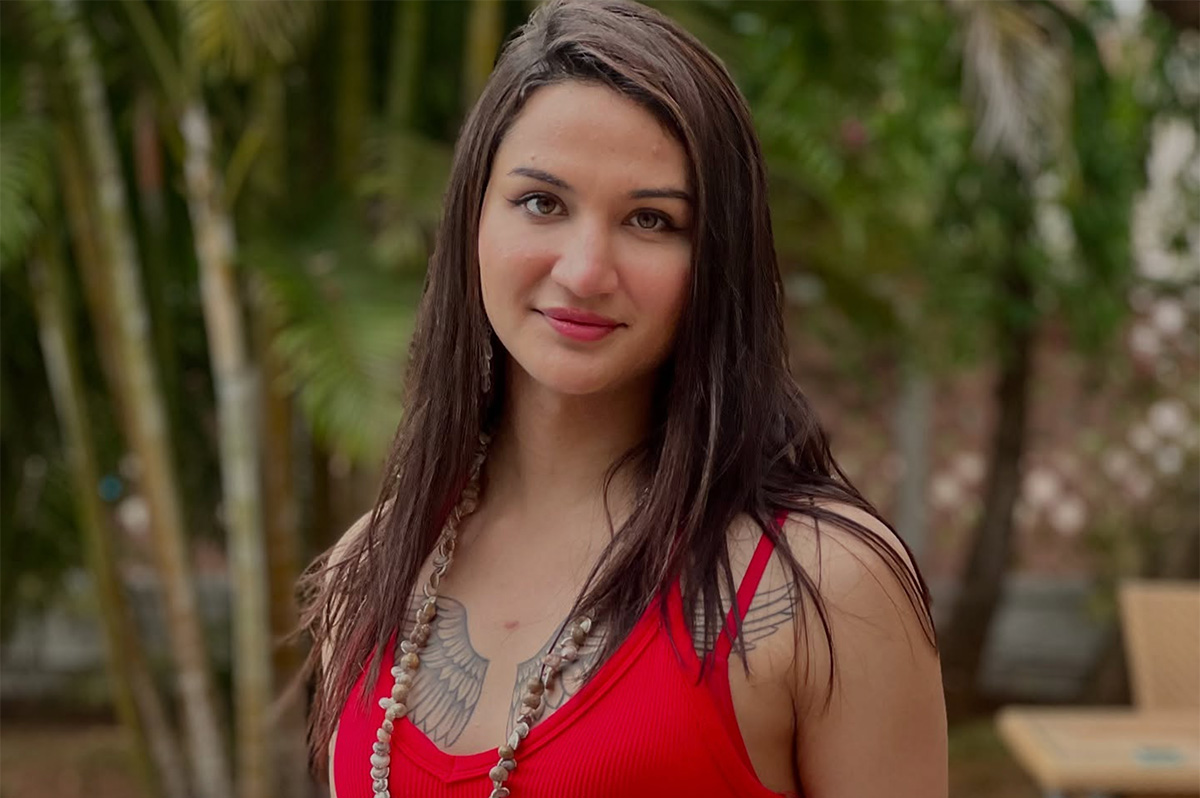
Anaya Bangar, the daughter of former Indian cricketer Sanjay Bangar, has partnered with the Manchester Metropolitan University Institute of Sport in the U.K. to assess her physiological profile following her gender-affirming surgery and undergoing hormone replacement therapy.
From January to March 2025, the 23-year-old underwent an eight-week research project that measured her glucose levels, oxygen uptake, muscle mass, strength, and endurance after extensive training.
The results, shared via Instagram, revealed her metrics align with those of cisgender female athletes, positioning her as eligible for women’s cricket under current scientific standards. Bangar’s findings challenge the International Cricket Council’s 2023 ban on transgender athletes in women’s cricket, prompting her to call for a science-based dialogue with the Board of Control for Cricket in India and the ICC to reform policies for transgender inclusion.
“I am talking with scientific evidence in my hand,” Bangar said in an interview posted to her Instagram page. “So, I hope, this makes an impact and I will be hoping to BCCI and ICC talking with me and discussing this further.”
On Nov. 21, 2023, the ICC enacted a controversial policy barring trans women from international women’s cricket. Finalized after a board meeting in Ahmedabad, India, the regulation prohibits any trans player who has experienced male puberty from competing, irrespective of gender-affirming surgery or hormone therapy. Developed through a 9-month consultation led by the ICC’s Medical Advisory Committee, the rule aims to safeguard the “integrity, safety, and fairness” of women’s cricket but has drawn criticism for excluding athletes like Canada’s Danielle McGahey, the first trans woman to play internationally. The policy, which allows domestic boards to set their own rules, is slated for review by November 2025.
Bangar shared a document on social media verifying her participation in a physiological study at the Manchester Metropolitan University Institute of Sport, conducted from Jan. 20 to March 3, 2025, focused on cricket performance. The report confirmed that her vital metrics — including haemoglobin, blood glucose, peak power, and mean power — aligned with those of cisgender female athletes. Initially, her fasting blood glucose measured 6.1 mmol/L, slightly above the typical non-diabetic range of 4.0–5.9 mmol/L, but subsequent tests showed it normalized, reinforcing the study’s findings that her physical profile meets female athletic standards.
“I am submitting this to the BCCI and ICC, with full transparency and hope,” said Bangar. “My only intention is to start a conversation based on facts not fear. To build space, not divide it.”
In a letter to the BCCI and the ICC, Bangar emphasized her test results from the Manchester Metropolitan University study. She explained that the research aimed to assess how hormone therapy had influenced her strength, stamina, haemoglobin, glucose levels, and overall performance, benchmarked directly against cisgender female athletic standards.
Bangar’s letter to the BCCI and the ICC clarified the Manchester study was not intended as a political statement but as a catalyst for a science-driven dialogue on fairness and inclusion in cricket. She emphasized the importance of prioritizing empirical data over assumptions to shape equitable policies for trans athletes in the sport.
Bangar urged the BCCI, the world’s most influential cricket authority, to initiate a formal dialogue on trans women’s inclusion in women’s cricket, rooted in medical science, performance metrics, and ethical fairness. She called for the exploration of eligibility pathways based on sport-specific criteria, such as haemoglobin thresholds, testosterone suppression timelines, and standardized performance testing. Additionally, she advocated for collaboration with experts, athletes, and legal advisors to develop policies that balance inclusivity with competitive integrity.
“I am releasing my report and story publicly not for sympathy, but for truth. Because inclusion does not mean ignoring fairness, it means measuring it, transparently and responsibly,” said Bangar in a letter to the BCCI. “I would deeply appreciate the opportunity to meet with you or a representative of the BCCI or ICC to present my findings, discuss possible policy pathways, and work towards a future where every athlete is evaluated based on real data, not outdated perceptions.”
Before her transition, Bangar competed for Islam Gymkhana in Mumbai and Hinckley Cricket Club in the U.K., showcasing her talent in domestic cricket circuits. Her father, Sanjay Bangar, was a dependable all-rounder for the Indian national cricket team from 2001 to 2004, playing 12 test matches and 15 One Day Internationals. He later served as a batting coach for the Indian team from 2014 to 2019, contributing to its strategic development.
Cricket in India is a cultural phenomenon, commanding a fanbase of more than 1 billion, with more than 80 percent of global cricket viewership originating from the country.
The International Cricket Council, the sport’s governing body, oversees 12 full member nations and more than 90 associate members, with the U.S. recently gaining associate member status in 2019 and co-hosting the 2024 ICC Men’s T20 World Cup. The BCCI generated approximately $2.25 billion in revenue in the 2023–24 financial year, primarily from the Indian Premier League, bilateral series, and ICC revenue sharing. The ICC earns over $3 billion from media rights in India alone for the 2024–27 cycle, contributing nearly 90 percent of its global media rights revenue, with the BCCI receiving 38.5 percent of the ICC’s annual earnings, approximately $231 million per year.
Women’s cricket in India enjoys a growing fanbase, with over 300 million viewers for the Women’s Premier League in 2024, making it a significant driver of the sport’s global popularity. The International Cricket Council oversees women’s cricket in 12 full member nations and over 90 associate members, with the U.S. fielding a women’s team since gaining associate status in 2019 and competing in ICC events like the 2024 Women’s T20 World Cup qualifiers. The BCCI invests heavily in women’s cricket, allocating approximately $60 million annually to the WPL and domestic programs in 2024–25, while contributing to the ICC’s $20 million budget for women’s cricket development globally. India’s media market for women’s cricket, including WPL broadcasting rights, generated $120 million in 2024, accounting for over 50 percent of the ICC’s women’s cricket media revenue.
“As a woman, I feel when someone says that they are women, then they are, be trans or cis. A trans woman is definitely the same as a cis woman emotionally and in vitals, and specially, when someone is on hormone replacement therapy. Stopping Anaya Bangar from playing is discrimination and violation of her rights. It is really sad and painful that every transwoman need to fight and prove their identity everywhere,” said Indrani Chakraborty, an LGBTQ rights activist and a mother of a trans woman. “If ICC and BCCI is stopping her from playing for being transgender, then I will say this to be their lack of awareness and of course the social mindsets which deny acceptance.”
Chakraborty told the Blade that Bangar is an asset, no matter what. She said that the women’s cricket team will only benefit by participation, but the discriminating policies are the hindrance.
“Actually the transgender community face such discrimination in every sphere. In spite of being potent, they face rejection. This is highly inhuman. These attitudes is regressive and will never let to prosper. Are we really in 2025?,” said Chakraborty. “We, our mindset and the society are the issues. We, as a whole, need to get aware and have to come together for getting justice for Anaya. If today, we remain silent, the entire community will be oppressed. Proper knowledge of gender issues need to be understood.”
The BCCI and the International Cricket Council have not responded to the Blade’s repeated requests for comment.
Theater
‘Andy Warhol in Iran’ a charming look at intersection of art, politics
Mosaic production plumbs kidnapping plot of iconic artist for humor
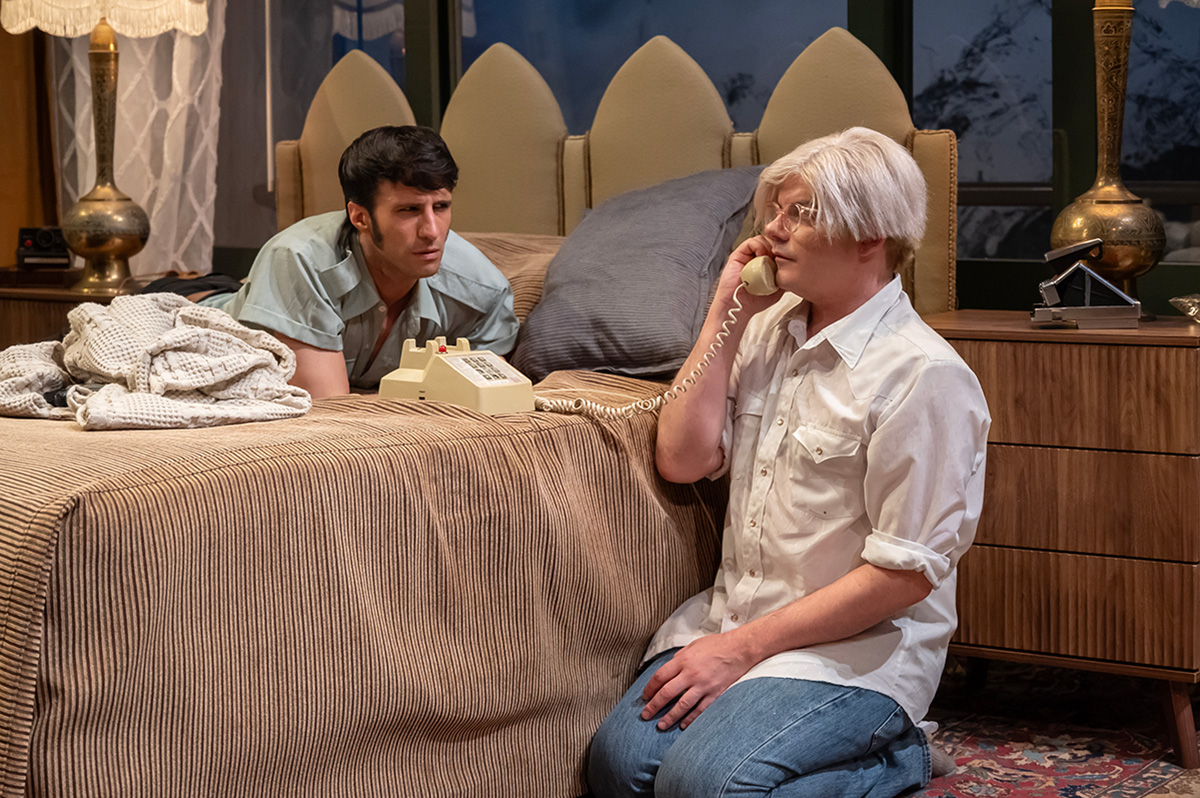
‘Andy Warhol in Iran’
Through July 6
Mosaic Theater Company at Atlas Performing Arts Center
1333 H St., N.E., WDC
$70
Mosaictheater.org
Behind the blasé veneer, Andy Warhol was more curious than people knew. Particularly when it came to money. He kept a close eye on how the ultra-rich lived, what fellow artists were being paid and who was paying them, and, of course, all the new and more saleable ways of making and selling art.
In playwright Brent Askari’s “Andy Warhol in Iran,” now playing at Mosaic Theater Company, Warhol (Alex Mills) is brought outside of his usual area of interest when he lands face to face with a young revolutionary. While Warhol could be artistically revolutionary, he didn’t connect with the idea of forgoing the pursuit of money and fame for the infinitely more difficult task of achieving social justice.
The 90-minute play is not fully factual, but rather inspired by Warhol’s real life 1976 trip to Tehran to make portraits of the royal Pahlavi family in the waning days of their reign, with a focus on Farah Diba, the Shah’s elegant wife and Iran’s last empress.
The action unfolds in a Tehran hotel suite boasting a glorious view of the snowcapped Alborz Mountains not far from Iran’s vibrant and bustling capital. It’s here, disguised as room service, that Farhad (played by Nathan Mohebbi) gains entrance to Warhol’s rooms, seeking to kidnap the pop art star to garner attention for the university students’ movement.
Warhol meets the armed intruder with a sort of wide-eyed wonderment, flummoxed why he has been selected for abduction. Warhol can’t understand why a young man like Farhad wouldn’t prefer to be paid a big ransom on the spot, or be cast as a star in one of the Warhol Factory flicks.
When Farhad replies it’s because Warhol is the most decadent artist in the world, Warhol mistakenly takes it for the ultimate compliment. After all, his biggest successes had been connected to celebrity and consumerism (think Campbell’s Soup Cans. 1962).
For Warhol, decadence is aspirational. He made portraits of financiers, movie stars, and jet setters. In fact, he’d been obsessed with the lives of the rich and famous since he was a small kid in Pittsburgh thumbing through Photoplay Magazine while bed bound with Saint Vitus Dance.
Accompanying Warhol to Tehran (unseen) are his business manager Fred Hughes, and Bob Colacello, editor of Interview magazine. Together, they make a merry trio of gay social climbers. These kinds of trips were a boon to the artist. Not only did they solidify a new strata of high society contacts, but were also superbly lucrative, thickly padding the painter’s pockets.
While in Iran, Warhol wanted only to view Farah’s vast world-class collection of jewels, sample the caviar on tap, and get his Polaroids. Then he’d fly first class back to New York and transfer the images to silk screen and sell the portraits to the Persian royals at a hefty price. He didn’t foresee any obstacles along the way.
Serge Seiden’s direction is spot on. He’s rendered a wonderfully even two-hander with a pair of terrifically cast actors. And Seiden plumbs the piece for humor mostly drawn from the absurdity of the situation without missing any of the serious bits.
As Warhol, out actor Mills is instantly recognizable as the eccentric artist. He’s wearing the button-down shirt, jeans, blazer, glasses, and, of course the famed shock of white hair wig (here a little more Karen than Andy). His portrayal is better than an imitation. He gives a bit of the fey and confused, but has also infuses him with a certain dynamism.
The energy works well with the intensity of Mohebbi’s would-be kidnapper Farhad. And while it isn’t a romance, it’s not impossible to think that Warhol might fall for a handsome male captor.
The connection between art and politics is almost always interesting; and though not a super deep dive into the era or the life of an artist, “Andy Warhol in Iran” is a compelling, charming, and sometimes funny glimpse into that intersection.
-

 U.S. Supreme Court3 days ago
U.S. Supreme Court3 days agoSupreme Court upholds ACA rule that makes PrEP, other preventative care free
-

 U.S. Supreme Court3 days ago
U.S. Supreme Court3 days agoSupreme Court rules parents must have option to opt children out of LGBTQ-specific lessons
-

 India5 days ago
India5 days agoIndian court rules a transgender woman is a woman
-

 National4 days ago
National4 days agoEvan Wolfson on the 10-year legacy of marriage equality



